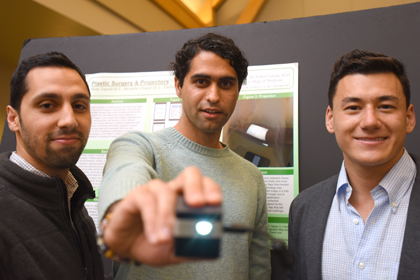Larner College of Medicine student research projects were among a record 440 projects showcased at the University of Vermont’s 2017 Student Research Conference on April 27, 2017 in the Davis Center’s Grand Maple Ballroom. The event – the largest in its 11-year history – was a display of student passion for research and poise in presentation.

Mustafa Chopan '17, Ross Sayadi '17, and Zach Ehret '20 present their new invention at the UVM Student Research Conference (Photo: Dave Seaver)
Larner College of Medicine student research projects were among a record 440 projects showcased at the University of Vermont’s 2017 Student Research Conference on April 27, 2017 in the Davis Center’s Grand Maple Ballroom. The event – the largest in its 11-year history – was a display of student passion for research and poise in presentation.
Plastic surgery and projectors
“Why not be perfect all the time?” says graduating medical student Mustafa Chopan ’17 in regards to a new invention that aims to ensure consistent accuracy in surgical markings for plastic surgery that he, classmate Ross Sayadi ’17 and Zachary Ehret ’20 developed and presented at UVM’s Student Research Conference. The concept for the projector – the second invention that Chopan and Sayadi have co-developed while in med school (the first was a special shoe for individuals with mobility issues) – emerged from their experiences observing plastic surgeons draw surgical markings free-hand. This increased the risk for mistakes and jeopardized patient safety, say the inventors. A software application with a database of markings enables surgeons to select pre-measured flaps, manipulate their size and position to fit the anatomical parameters of each patient, and use them as a stencil that can be projected onto the skin. The two have also established the Plastic Surgery Student Interest Group, designed to serve as a kind of “legacy” for the medical students behind them, like Ehret, who exhibited a keenness and determination that made him a perfect partner for their research project. “We want to ensure the spirit of creativity and pushing the boundaries lives on,” says Sayadi. (Advisors: Robert Nesbit, M.D., and Donald Laub, M.D., Department of Surgery)
Providing refuge for the homeless
Mike Hudson ’17 was making a good living in computer security when he decided to volunteer at a health care clinic in a homeless shelter. “It just lit me on fire,” he says. “It was clear that I needed to stop chasing money and actually do something that I loved.” That involved enrolling in the Larner College of Medicine and becoming a political advocate for the homeless. His research project focused on whether or not Burlington’s first homeless shelter to accept people with drug or alcohol addictions reduced visits to the emergency department (ED). Previously, homeless individuals often relied on the ED for medical help or a place to stay during colder months. Although the opening of a permanent shelter, which gave previously homeless individuals a permanent address, skewed his data, Hudson found a modest decrease. “Providing housing to the homeless has significant health benefits and lowers costs. It has become clear that the best way for me to help is through political advocacy and by fulfilling my dream of working at a Federally Qualified Health Center.” (Advisor: Martha Seagrave, PA-C, R.N., Department of Family Medicine)
Confidential texting service for LGBTQ health questions
Class of 2017 medical student Matthew Shear first partnered with Outright Vermont, a Burlington-based LGBTQ youth service organization, in 2013 as part of a Schweitzer Fellows project that he and classmate Leah Cipri ’17 conducted to establish and staff a confidential reproductive health text messaging service. His research project evaluated the reach and utilization of this text messaging service for LGBTQ youth with reproductive and sexual health questions. Shear analyzed text message inquiries submitted to the service from 2013-2017 for their content by tagging each inquiry with qualitative descriptors, and quantifying the frequency of each tag. Summary statistics were calculated including the number of clients accessing the service, clients’ area code, and length of each text conversation. Shear discovered that the service has received 300 inquiries, two-thirds of which were from an 802 area code, on topics ranging from safer sex to reproductive science and from relationships and communication to trans* and gender identity. These results underscored the value of the texting service as a resource for LGBTQ youth within Vermont. (Advisor: Nathalie Feldman, M.D., Department of Obstetrics, Gynecology and Reproductive Sciences)
(Note: Some content in this article was adapted from a story, titled “Student Research, Front and Center,” by Jon Reidel, University Communications.)